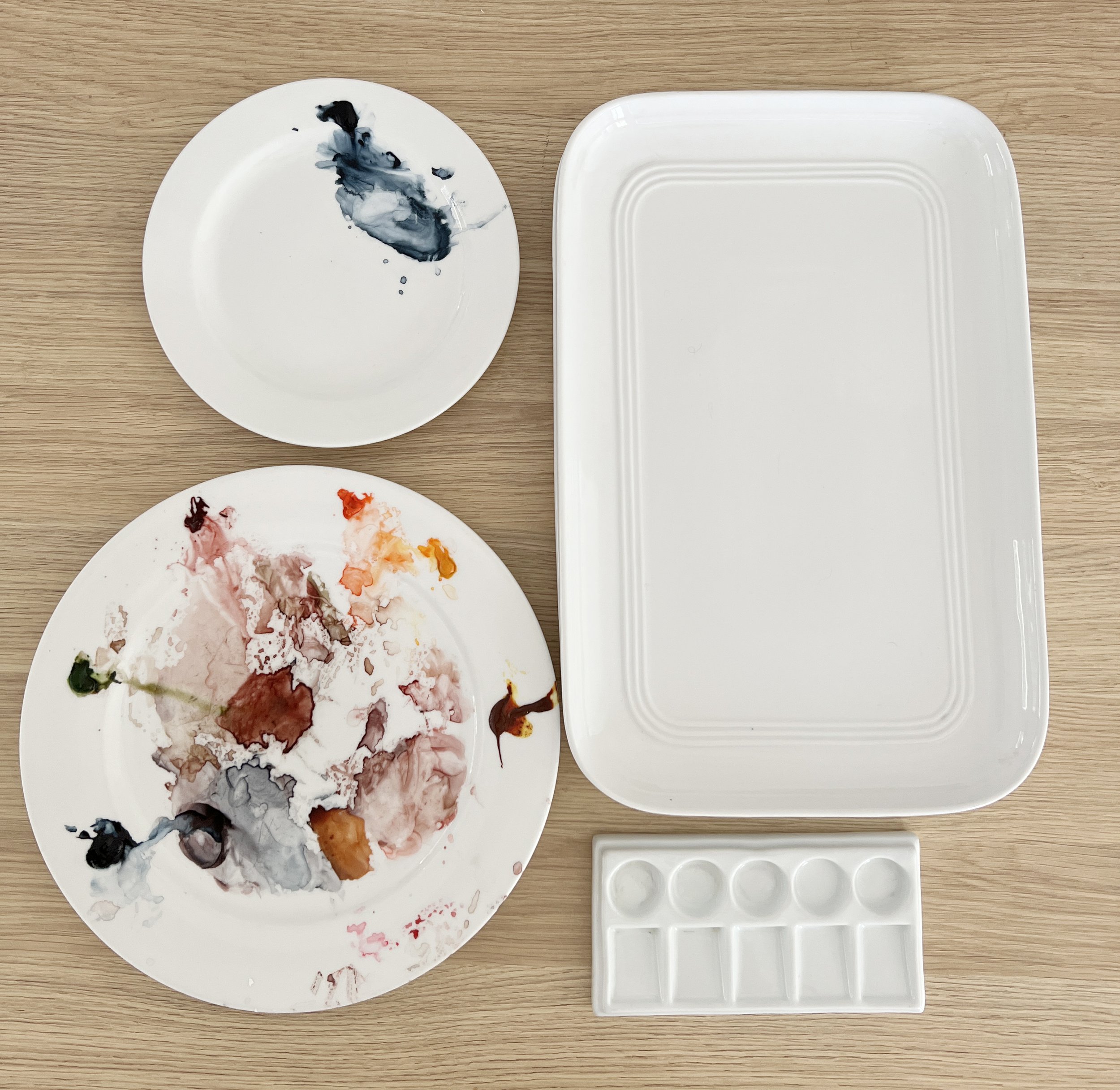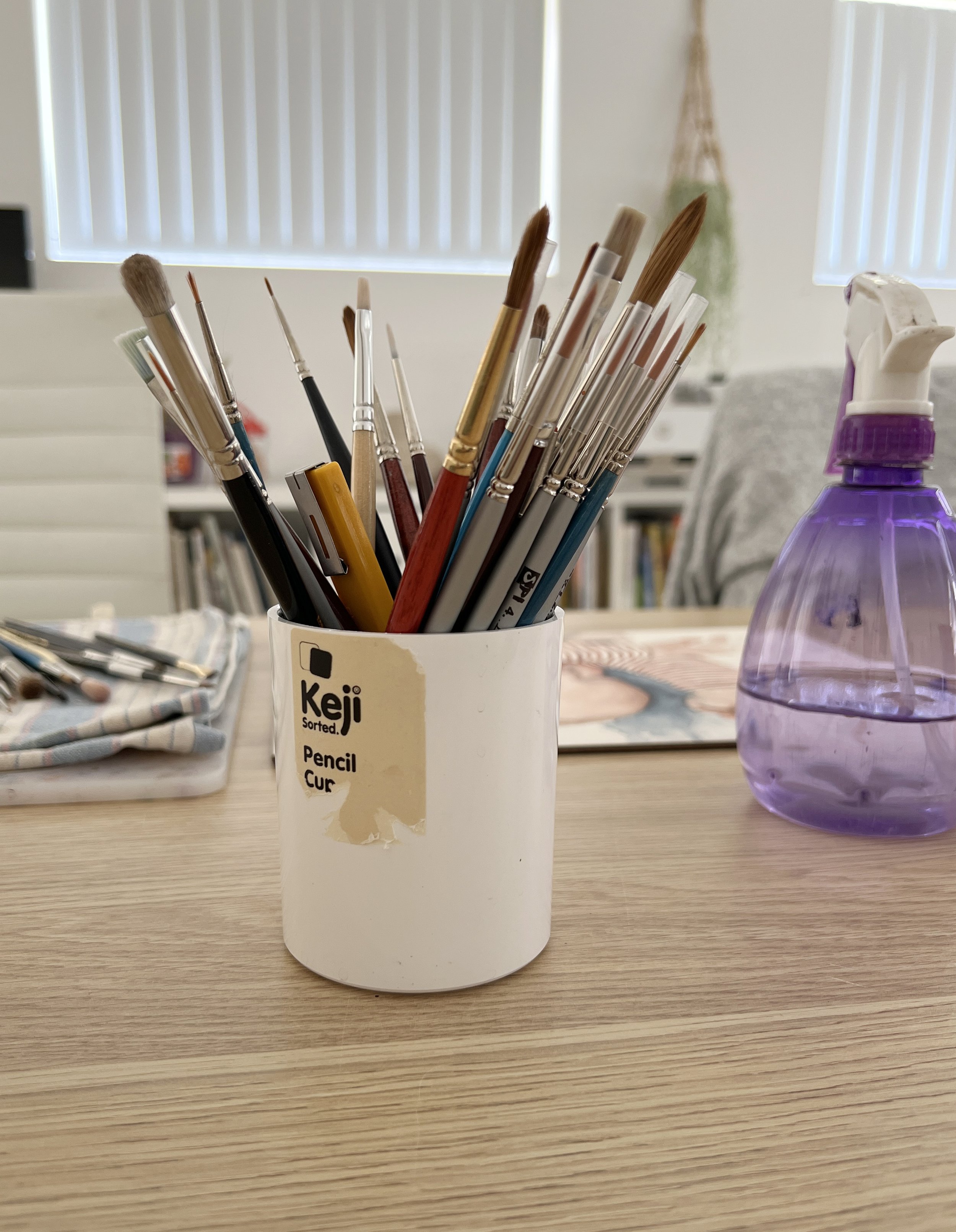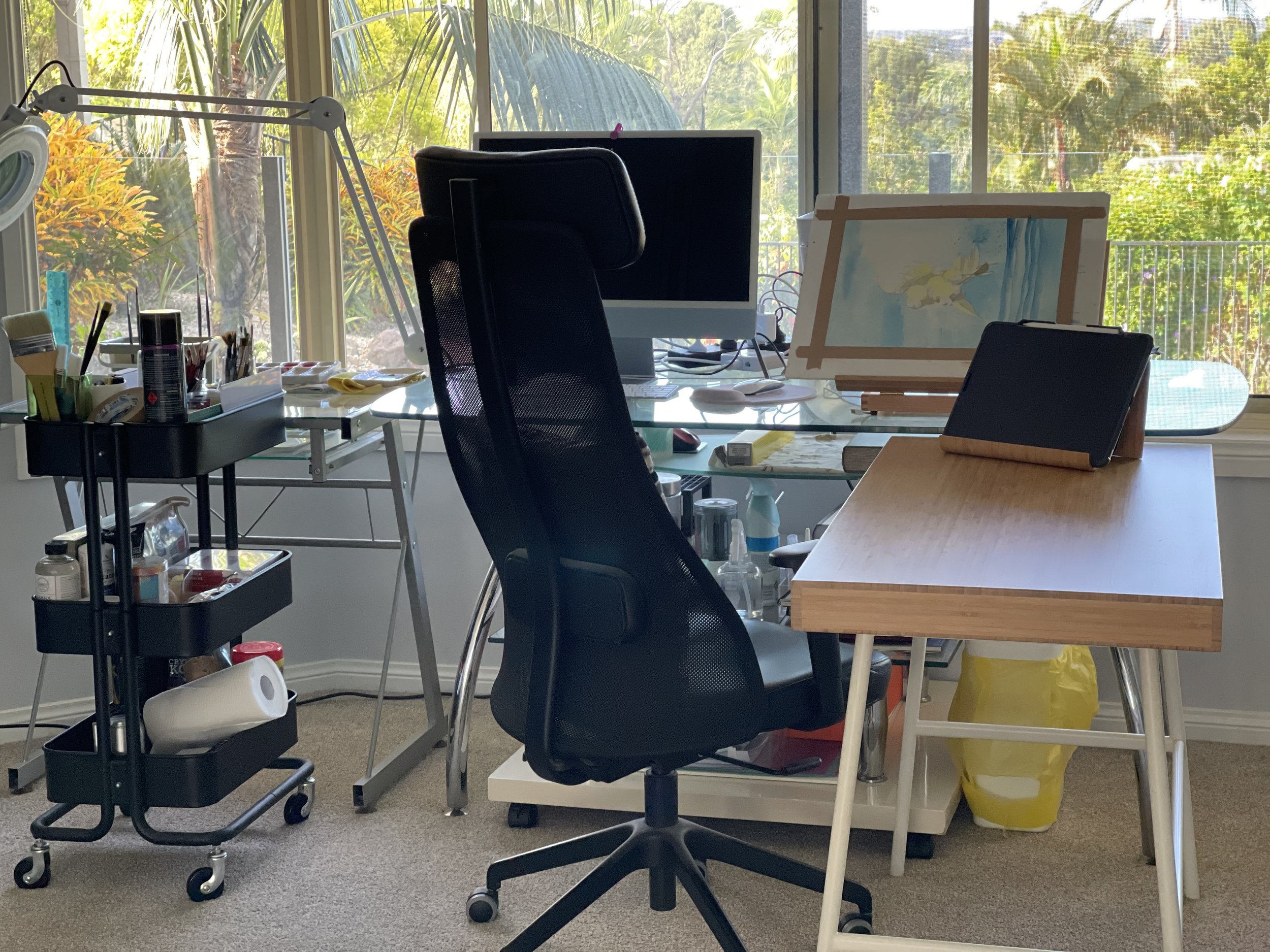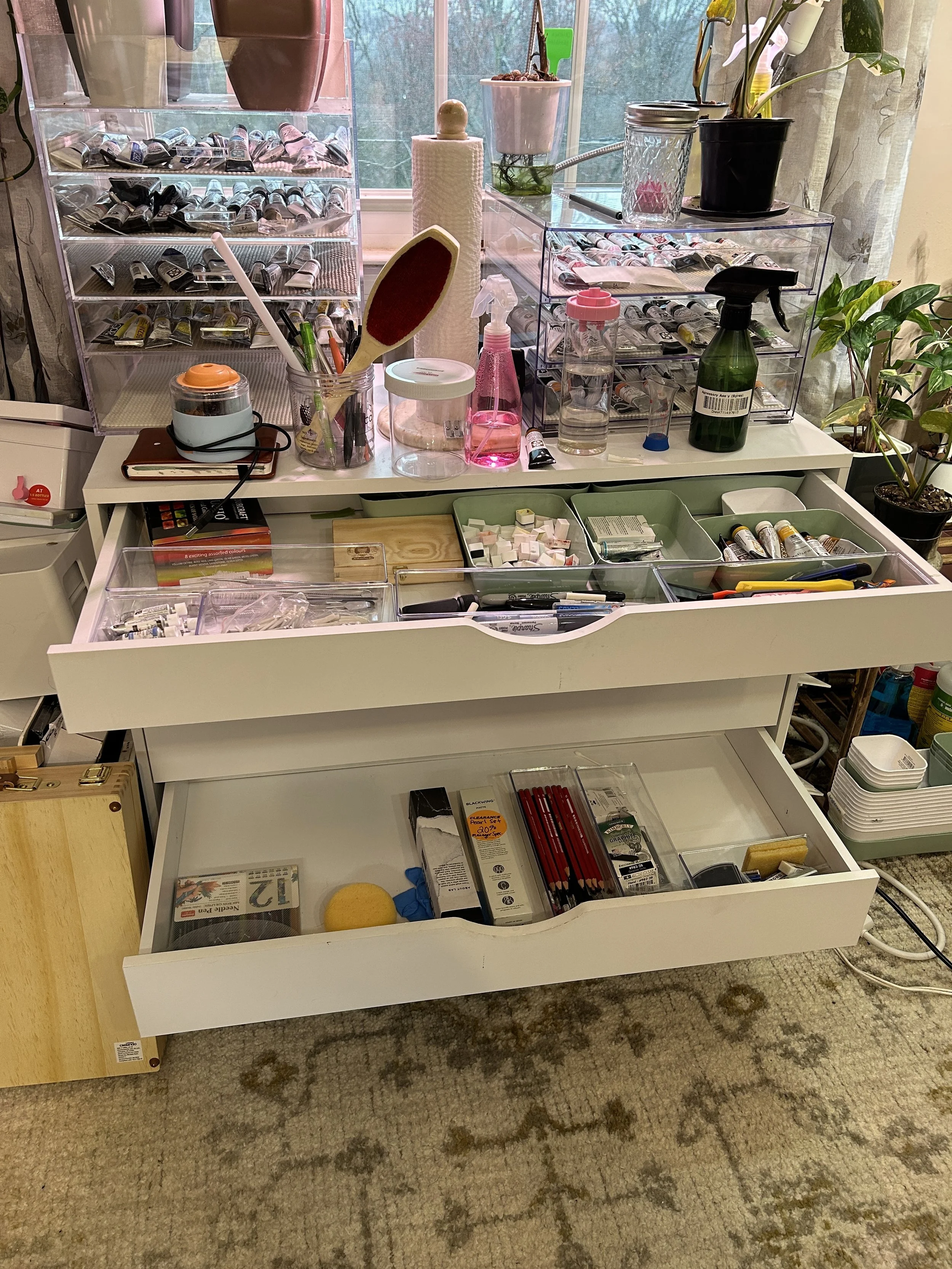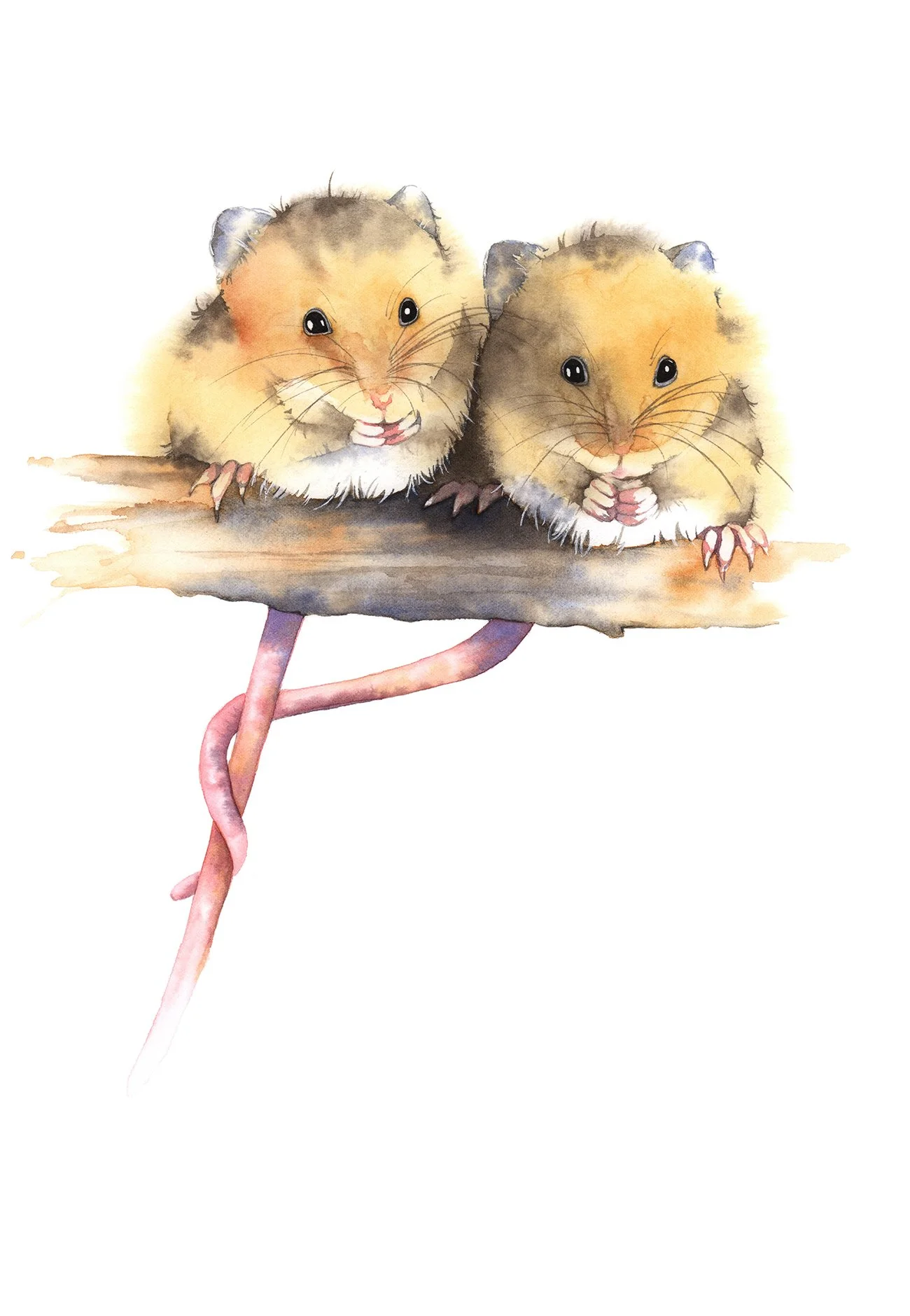Crafting Your Watercolour Workspace: Starting Small with Big Dreams
Embarking on the journey of watercolour painting doesn’t require an expansive art studio or an arsenal of expensive tools. Quite the contrary, the beauty of watercolour lies in its simplicity and the intimate connection between artist and medium.
Today, I'm going to guide you through setting up a modest, yet profoundly functional watercolour art desk setup that resonates with the ethos of beginning small—with the potential for your passion and skills to grow expansively.
At the end of the blog post, I have included pictures of Patreon students' workplaces to show you, how diverse desk setups can be and still work individually. Thanks to everyone showing us their creative nests!
Embracing Space in the Smallest Places
Our tiny apartment in Sydney. I would sit every day and paint at that little white dining table.
When I started to paint with watercolour daily, my husband Dom and I lived in a small studio apartment in Sydney. Each day, when he left for work, I would bring all my materials to the kitchen table to paint and removed everything again, so we could eat together. Even in our house, in Coffs Harbour, I didn’t have a dedicated room or art studio, for the longest time.
If you don’t have a dedicated space, making art doesn’t need a lot. I have a student who painted on the sofa with a watercolour pad on her knees. No matter what your situation might be, I encourage you to find room and space for art – you won’t regret it.
The Foundation: Your Table
The heart of your workspace is your table. It doesn’t need to be large, but it should be stable. A dining table can serve well, but if you’re pressed for space, a small foldable table can be just as effective. Ensure it's at a comfortable height to prevent any strain during those longer painting sessions. If you want to really treat yourself, get an adjustable standing desk or one that you can put in an angle. A flexible standing desk can offer a great variety, which our backs and discs really like.
Your desk setup only needs to be very basic.
The angle of your paper can greatly affect the flow of your paint. Prop up one end of your table or use a drawing board to create a slight incline. This can be as simple as placing a thick book on the desk, under your paper or board. The incline aids in the gravitational flow of the paint, offering you more control and creating interesting effects with washes.
Sometimes I'll use a thick book to incline my painting board.
As important as your desk is your chair. You want it to be comfortable enough to be able to paint hours at a time, but not too comfortable that your posture suffers. Getting up after a lengthy painting session can leave you a little bit raw and stiff. Aim for an ergonomic chair or ergonomic office chair if you can afford it and have the room for it. If that isn't in your budget, take regular breaks where you stand up and move your muscles and limbs.
Remember, your space is sacred; keep it clean and organised and free from visual clutter to foster a serene environment where creativity can blossom.
Lighting: The Importance of Daylight Lamps
Sufficient natural lighting is your best friend, but it’s not always available. A good quality daylight lamp can be a game-changer, especially for those late-night creative bursts or for the grey days when the sun decides to hide.
These lamps simulate natural daylight, ensuring your colours remain true to life and reducing eye strain. Position your lamp to illuminate your setup and artwork evenly, ideally coming from your non-dominant side to minimise shadows.
For my lighting over my painting desk I use a Lumi Daylight Task lamp.
Some of my palettes are ordinary white dinner plates. I also have some inexpensive white ceramic platters that I bought at Kmart for about $5. They are excellent for mixing the paint on.
Palette Solutions: Embracing the Affordable
Who said you need an expensive palette to start? A ceramic plate, a piece of tile, or even a glossy plastic tray can serve as excellent substitutes. What matters is a surface you can mix your colours on; the rest is innovation and resourcefulness.
These alternatives not only save costs but also add a personal touch to your painting process. I prefer ceramic plates to plastic or metal trays, as colour can stain them, but it is up to you.
Jars and Water Containers: The Essence of Watercolour
Water management is crucial in watercolour painting. Have at least two jars of water at hand - one for washing your brushes and the other for clean water to mix with your paints. This helps keep your colours vibrant and uncontaminated. Recycled jars or containers can work perfectly, embodying the spirit of resourcefulness. They don’t have to be fancy or a special size. I use a big, plastic container, which lets me paint for a long time, without having to get up to refresh the water all the time.
I have a big plastic water container that I bought at a hardware store in the paint section.
Keep your brushes organized in a simple brush container.
Holders: Order in Creativity
Keeping your brushes organised and within reach is essential. A simple cup or mug can serve as an effective brush holder. For those who wish to go a step further, repurposed old holders or even crafting one from clay or wood can add a unique and personalised touch to your workspace.
Choreographing Creativity: The Art of Workspace Arrangement
Arrange your desk to get that creativity flowing.
The way you organise your workspace can significantly impact your artistic flow, much like a well-prepared table sets the scene for a meal. Imagine your workspace as a canvas, where each element — from palettes to brushes, from water jars to the paper itself — is positioned not merely by necessity, but with an intuitive grace. This deliberate placement allows the artist to move with rhythm and purpose, ensuring that each stroke of genius is not hindered by the physical search for the right tool, but rather, each tool finds its way into the artist's hand as if by magic. In embracing such an arrangement, we not only optimise our physical space but also clear a path for creativity to flow unimpeded, making room for inspiration in even the most confined quarters.
Assembling the Artist's Toolkit: Beyond Paint and Brushes
Equipping your watercolour workspace extends beyond the basic palette and brush. Each artist's toolkit should include a variety of supplementary items: paper towels for dabbing brushes and correcting mistakes, a pencil and eraser for initial sketches, masking fluid to protect specific areas from paint, sponges for texture, and tape to secure paper. These tools, though seemingly modest, play crucial roles in the creative process. Their presence within arm's reach enriches the painting experience, enabling the artist to explore and execute with precision and flair, ensuring that every stroke and texture intended can be achieved with ease. If your workspace doesn’t allow for them to be placed on the desk, get creative. It's important to stay in the creative flow, instead of rummaging through your belongings to find your tools.
Remember, the essence of watercolour painting lies in the blend of simplicity and creativity. Your workspace reflects your artistic journey—beginning small doesn’t mean thinking small. Each brush stroke you create is a step towards mastery, and your modest workspace is the crucible where your artistic potential will flourish.
Let your workspace be a place of discovery, growth, and profound creativity. Watercolour painting is not just about the final piece; it's about the journey, the experimentation, and the joy found in every drop of paint. Embrace the process, and your workspace will be your sanctuary of creativity.
Students' spaces
Inspired by the themes of creativity and efficient workspace arrangements we've explored, let's extend this journey beyond our studios. I invite you to discover the following unique art spaces of our Patreon students, a testament to the diversity and personalisation of creative environments. Witness how each artist tailors their space to foster inspiration and productivity.
Leisa's creative nook
Leisa used to paint on her dining table. But now that she has become and empty nester, its been reclaimed for its intended use. She now has a dedicated art space in her son’s old bedroom. The desk setup offers a lot of natural light and wall space to hang her beautiful creations.
Leisa has a dedicated art space in her son's old bedroom.
Violet's creation corner
Violet built a drop leaf table on casters to give me more working space and make it mobile.
Violet does a variety of projects, including sewing clothes, and it all happens in this space. Her cabinet used to be a TV armoire, that her parents bought when she was 15 years old. They gave it to her when she turned 24. She now is 41, so that cabinet has seen some miles. She built a drop leaf table to give her more working space. She also added an LED strip light and a pegboard.
Violet put it on heavy duty caster wheels so she can move it easier. She already moved house 5 times with "that beast" and moved rooms in her houses several times - wheels only got added after the last move. She has a family of 5 children aged 5-16, so space is hard to come by. She is really looking forward to having her own craft room in 2 years.
Violets space has lovely indirect light and you can see her creativity from a mile away.
Kimberly's creative haven
In her cozy corner of a small 75 sqm apartment situated in the living room, Kimberly has created a personal space dedicated to her passion for painting. Central to this space is a desk with various tools of the trade: a pencil holder repurposed as a watercolour brush holder sits beside a printer. Attached to the desk, a white wall organiser serves as a home for pencils, masking tape, and other miscellaneous items. The computer, stationed at this desk, is crucial for Kimberly for following tutorials, positioned in such a way to maximise the remaining desk space when the keyboard is pushed closer.
Kimberly has innovated a drying system for her brushes by employing a silicone brush holder that allows brushes to hang upside down, ensuring they dry properly without damaging the bristles—a lesson learned the hard way after a previous incident bent them. Illumination is provided by a black daylight lamp, indispensable for those darker hours when natural light wanes, ensuring she can see precisely where she has wet her paper or applied her paint.
This is Kimberly's corner in a small 75 sqm apartment in the living room. It has a lot of natural right and there’s a large sliding window on the left.
Mobility and storage solutions are thoughtfully integrated into the space with little cabinets on wheels and a green cart, making everything easily accessible yet out of the way when necessary. These storage units house a variety of materials from art books and sketchbooks to measuring tools, catering to the Kim's diverse interests that span beyond watercolours to include illustrations, ink, gouache, and markers. A larger cabinet discreetly stores bigger items like larger paper, finished paintings, line drawings, chargers, and painting towels, ensuring a semblance of order in this creative oasis.
In one corner, wooden boards lie ready for stretching paper. Despite its limited size, the space is brightened by ample natural light streaming in from a large sliding window on the left, adding a sense of openness and inspiration. However, Kimberly’s creative haven comes with its challenges, notably the need to tidy up after each session to prevent the space from descending into chaos—a small price to pay for creating a dedicated corner to pursue her art in the heart of her living space.
Alirat's inspiration den
Ali's new space is complete with a newly installed overhead light. It has 3 temperature settings and she is currently testing a medium setting, before she tries to warm it up. She says, that she thrives on chaos, but in her creative den, everything she needs is close to hand. Ali has a wonderful, big window in front of her desk and a lot of storage space in close range. She can angle her paper up while following tutorials - all on the same desk.
Alirat has a space complete with newly installed overhead light.
Sally's artistic retreat
Sally's painting corner has a lovely view of the garden. She has two shelves in the unit on the left hand side, that hold sketchbooks and some paints. The closed cupboard offers room for more paint and paper. The drawers under the printer hold miscellaneous items, such as rulers, eradicator brushes, shimmery watercolours, pencils and posca pens. She has plenty of ceramic palettes, but now usually uses the stackable ones, as they take up less space. Two big water buckets and plenty of brushes, pens are always ready for a spontaneous painting session. You may just see tube paints peeking out from behind the computer. Sally cleverly uses an acrylic lipstick holder to store them. It makes life easier!
Sally's painting corner has a nice view of the garden! The two shelves in the unit (left) hold sketchbooks and paints.
Moe's watercolour wonderland
Moe's space is actually the second living space which has a good light and nobody uses, so she cleverly modified it as her heaven . It is the combination of the secondhand dining table (with an underneath coffee table and her office table, which allows her to set up exactly as she wants it. It took her 2 years to get the space right. Moe also finds space in her room to put up her beautiful finished paintings, paints and brushes. She started painting about 2-3 years ago and began her art journey with colour pencils to create realistic drawings. Later, she swapped to watercolour and has been following my tutorials to advance her skills. Colours and painting are Moe’s stress medicine and she finds happiness just in thinking about what she will paint next or which colours to use. She has a full-time job and regards painting as a hobby but is looking forward to retirement to be able to paint whenever she wants. Her space is very neat, bright and tidy and makes for a beautiful creative outlet.
This is Moe's second living space which has a good light and nobody uses it so she modified it as her heaven.
Miczup's art oasis
Her space is located in the guest/office room. Miczup has just recently set it up with a peg board and shelf that she built herself. The brushes she uses the most are on the table in an old jam jar and a small vase. Miczup has 2 ceramic palettes and some plain white plates that she got from the dollar store to mix her paints. She cleverly repurposed a pasta sauce jar and glass candle jar as water containers. She also has a small stand for her ipad which is where she watches the tutorials or looks at reference photos. The pink drawers next to the desk hold various other craft supplies. Most of the painting supplies and finished paintings are stored in the large flat file drawers that Miczup got from someone in town who was just giving it away. They nearly broke her husband’s back with how heavy they were but she says they are so worth it. Just some sanding and new paint and they were as good as new. She also wanted to share the little statue her grandmother gave her when she was a little girl. It had a French flag that disintegrated years ago but the wonderful ladies on Discord helped her replace it with this little saying. Miczup absolutely loves her painting space, its her happy place. And its easy to see why. It offers lots of space to creative freedom while everything is neatly organized and full of charming little details.
Miczup has a space located in the guest/office room. She had just recently set it up with a peg board and shelf that she built herself.
The little statue her grandmother gave her when she was a little girl.
Candy's canvas cove
Candy's space quintuples as a few different things. It's the only 10X12 room in the house that she can claim, and she does a lot in it, except sleep. Her art space is also her work space where she works 4 days a week, from home.
Candy's space is multipurpose as she works from home 4 days a week.
On her right is the only storage in this little space.
When she's not doing that, she does a multitude of other things there. Her only storage is a lovely drawer with all the things she needs to be creative.
The room also serves as a plant room and as a safe haven for the cats, so that the dogs don't eat their food. She also does photogaphy in there and of course paint. She's only got a little corner of her working desk dedicated for it, but she's making it work. She can also comfortably see the screens from there.
Jewell's artistic lair
Jewell only recently upgraded from painting on her knees to a dedicated desk, which she chose with the help of the Discord community. She absolutely loves it. She has some desk drawers - palettes on the right side, and a collection of other materials on the left. She uses an old bookshelf for her large collection of paper, more watercolour palettes, that don't fit anywhere else, as well as brushes, empty pans, and painting mediums. Jewell says she doesn't organise it, as the cat knocks stuff over weekly, a favourite game of hers (the cat, not Jewell) 😂. She organised her tube paints in colourful little boxes. The grey box is full of Winsor Newton paints , the yellow bee box is filled with Daniel Smith, and the right pink box is all of her Daniel Smith watercolour sticks. Jewell loves pink and made her work space a lovely, inspiring place to work.
Jewell has a desk that she's in love with! She bought it to stop painting on her knees on the couch.
Edith's palette palace
Edith shares a small room with her husband. She's hoping to soon upgrade to a bigger table space and to eventually take over her son’s room, as soon as he leaves for university education. Edith has a lot of natural lighting and storage space. Unique items make the room really inviting and cozy.
Edith shares a small room with her husband (as an office) and hopes to take over her son's room when he moves to his university dormitory.
Laura's art sanctuary
Laura recently convinced her husband to let her take over his room and she is so excited to finally be able to paint upstairs. She says, she used to paint downstairs in very low light. Her place is very neat and organised with natural lighting and lots of space for artistic expression. (Love the cozy slippers!)
Laura also has a shared space in a multipurpose room. Her desk setup is clean and uncluttered.
Cindy's painter’s alcove
Cindy's desk is actually their kitchen table as she and her husband both are empty nesters and retired. Although she has two empty rooms upstairs, she prefers being downstairs and her husband likes having her around. Cindy's personality really shines through with her setup. She has lots of small ceramic plates and bowls holding water and paints. She also has a cabinet with lots of drawers for her paper and paints. Her husband often sits next to her at the bar while she paints, enjoying each other’s company, as well as their two dogs, who are always around.
Cindy is an empty nester and uses her kitchen table to paint on. She prefers to be downstairs with her husband and his motto is "Happy wife Happy life".
This is Cindy’s cabinet that holds all of her paper and paints.
Thank you again to all of my lovely patrons who shared their workspaces with us. ❤️
Video on YouTube
I also made a video of my students’ spaces on YouTube.
If you are interested in learning to paint in watercolour, I have over 170 online, voiced over watercolour tutorials for all skill levels.




